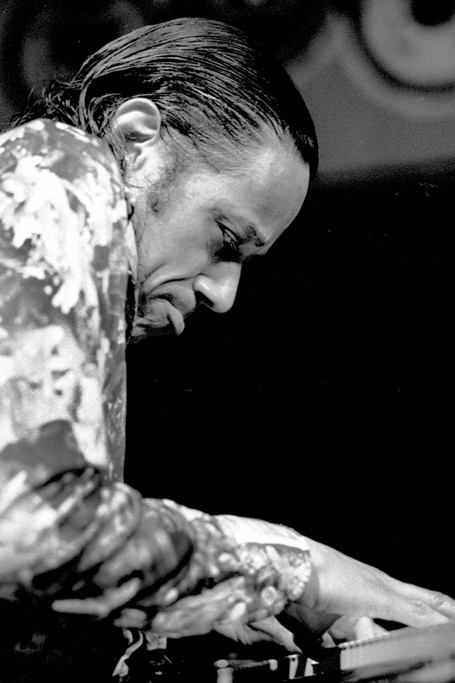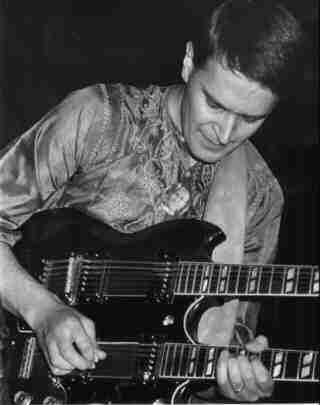|
List Of Jazz Saxophonists
Jazz saxophonists are musicians who play various types of saxophones (alto saxophone, tenor saxophone, baritone saxophone etc.) in jazz and its associated subgenres. The techniques and instrumentation of this type of performance have evolved over the 20th century, influenced by both movements of musicians that became the subgenres and by particularly influential sax players who helped reshape the music. In the 1930s, during the swing and big band era, saxophonists like altoist Johnny Hodges (1906–1970), who led the saxophone section in the Duke Ellington Big Band, were featured soloists in a highly structured system of playing where such solos were limited moments of musical freedom. In the early 1940s, jazz saxophonists such as Charlie Parker (alto, tenor) and Sonny Stitt (alto, tenor) led a rebellion against the strictures of big band jazz, shifting away from danceable popular music towards a more challenging "musician's music" that would come to be called bebop, with ... [...More Info...] [...Related Items...] OR: [Wikipedia] [Google] [Baidu] |
Saxophone
The saxophone (often referred to colloquially as the sax) is a type of single-reed woodwind instrument with a conical body, usually made of brass. As with all single-reed instruments, sound is produced when a reed on a mouthpiece vibrates to produce a sound wave inside the instrument's body. The pitch is controlled by opening and closing holes in the body to change the effective length of the tube. The holes are closed by leather pads attached to keys operated by the player. Saxophones are made in various sizes and are almost always treated as transposing instruments. Saxophone players are called '' saxophonists''. The saxophone is used in a wide range of musical styles including classical music (such as concert bands, chamber music, solo repertoire, and occasionally orchestras), military bands, marching bands, jazz (such as big bands and jazz combos), and contemporary music. The saxophone is also used as a solo and melody instrument or as a member of a horn section in som ... [...More Info...] [...Related Items...] OR: [Wikipedia] [Google] [Baidu] |
Hard Bop
Hard bop is a subgenre of jazz that is an extension of bebop (or "bop") music. Journalists and record companies began using the term in the mid-1950s to describe a new current within jazz that incorporated influences from rhythm and blues, gospel music, and blues, especially in saxophone and piano playing. David H. Rosenthal contends in his book ''Hard Bop'' that the genre is, to a large degree, the natural creation of a generation of African-American musicians who grew up at a time when bop and rhythm and blues were the dominant forms of black American music. Prominent hard bop musicians included Horace Silver, Clifford Brown, Charles Mingus, Art Blakey, Cannonball Adderley, Miles Davis, John Coltrane, Hank Mobley, Thelonious Monk and Lee Morgan. Musical style Hard bop is sometimes referred to as "funky hard bop". The "funky" label refers to the rollicking, rhythmic feeling associated with the style. The descriptor is also used to describe soul jazz, which is commonly a ... [...More Info...] [...Related Items...] OR: [Wikipedia] [Google] [Baidu] |
Smooth Jazz
Smooth jazz is a genre of commercially-oriented crossover jazz and easy listening music that became dominant in the mid 1970s to the early 1990s. History Smooth jazz is a commercially oriented, crossover jazz which came to prominence in the 1980s, displacing the more venturesome jazz fusion from which it emerged. It avoids the improvisational "risk-taking" of jazz fusion, emphasizing melodic form and much of the music was initially "a combination of jazz with easy-listening pop music and lightweight R&B". During the mid-1970s in the United States it was known as "smooth radio", and was not termed "smooth jazz" until the 1980s. Notable artists The mid- to late-1970s included songs “Breezin'" as performed by another smooth jazz pioneer, guitarist George Benson in 1976, the instrumental composition " Feels So Good" by flugelhorn player Chuck Mangione, in 1978, " What You Won't Do for Love" by Bobby Caldwell along with his debut album was released the same year, jazz fusion gr ... [...More Info...] [...Related Items...] OR: [Wikipedia] [Google] [Baidu] |
David Sanborn
David William Sanborn (born July 30, 1945) is an American alto saxophonist. Though Sanborn has worked in many genres, his solo recordings typically blend jazz with instrumental pop and R&B. He released his first solo album ''Taking Off'' in 1975, but has been playing the saxophone since before he was in high school. One of the most commercially successful American saxophonists to earn prominence since the 1980s, Sanborn is described by critic Scott Yannow as "the most influential saxophonist on pop, R&B, and crossover players of the past 20 years." He is often identified with radio-friendly smooth jazz, but he has expressed a disinclination for the genre and his association with it. Early life Sanborn was born in Tampa, Florida, and grew up in Kirkwood, Missouri. He suffered from polio for eight years in his youth. He began playing saxophone on a physician's advice to strengthen his weakened chest muscles and improve his breathing, instead of studying piano. Alto saxophonis ... [...More Info...] [...Related Items...] OR: [Wikipedia] [Google] [Baidu] |
Bob Mintzer
Robert Alan Mintzer (born January 27, 1953) is an American jazz saxophonist, composer, arranger, and big band leader. Early life Mintzer was born and raised in a Jewish family in New Rochelle, New York, on January 27, 1953. He attended the Interlochen Arts Academy, Michigan from 1969 to 1970, then was at the Hartt School of Music, Hartford, Connecticut for two years, before attending the Manhattan School of Music from 1972 to 1974. Later life and career Early in his career, Mintzer played in various big bands, including those led by Buddy Rich (1975–77), Thad Jones and Mel Lewis (1977–79), and Sam Jones (1978–80). While with Rich, he began writing big band music, and has since composed and arranged hundreds of pieces. In 2008, Mintzer and his family moved to Los Angeles, where he joined the faculty of the University of Southern California. He is a member of the Grammy award-winning Yellowjackets and holds the Buzz McCoy endowed chair of jazz studies at the University of S ... [...More Info...] [...Related Items...] OR: [Wikipedia] [Google] [Baidu] |
Kenny G
Kenneth Bruce Gorelick (born June 5, 1956), known professionally as Kenny G, is an American smooth jazz saxophonist, composer, and producer. His 1986 album ''Duotones'' brought him commercial success. Kenny G is one of the best-selling artists of all time, with global sales totaling more than 75 million records. Early life Kenny G was born in Seattle, Washington to a Jewish family. His mother was a Canadian Jew from Saskatchewan, Canada. He came into contact with the saxophone when he heard a performance on ''The Ed Sullivan Show''. He started playing the saxophone, a Buffet Crampon alto, in 1966 when he was 10 years old. Kenny G attended Whitworth Elementary School, Sharples Junior High School (renamed Kurose Middle School), Franklin High School, and the University of Washington, all in his home city of Seattle. When he entered high school he failed at his first attempt to get into the jazz band but auditioned again the following year and earned first chair. His Frankl ... [...More Info...] [...Related Items...] OR: [Wikipedia] [Google] [Baidu] |
Michael Brecker
Michael Leonard Brecker (March 29, 1949 – January 13, 2007) was an American jazz saxophonist and composer. He was awarded 15 Grammy Awards as both performer and composer. He was awarded an Honorary Doctorate from Berklee College of Music in 2004, and was inducted into the ''DownBeat'' Jazz Hall of Fame in 2007. Biography Early life and career Michael Brecker was born in Philadelphia and raised in Cheltenham Township, a local suburb. He was raised in a Jewish—and artistic—family: his father, Bob (Bobby), was a lawyer who played jazz piano and his mother, Sylvia, was a portrait artist. Michael Brecker was exposed to jazz at an early age by his father. He grew up as part of the generation of jazz musicians who saw rock music not as the enemy but as a viable musical option. Brecker began studying clarinet at age 6, then moved to alto saxophone in eighth grade, settling on the tenor saxophone as his primary instrument in his sophomore year. He graduated from Chelte ... [...More Info...] [...Related Items...] OR: [Wikipedia] [Google] [Baidu] |
Wayne Shorter
Wayne Shorter (born August 25, 1933) is an American jazz saxophonist and composer. Shorter came to prominence in the late 1950s as a member of, and eventually primary composer for, Art Blakey's Jazz Messengers. In the 1960s, he joined Miles Davis's Second Great Quintet, and then co-founded the jazz fusion band Weather Report. He has recorded over 20 albums as a bandleader. Many Shorter compositions have become jazz standards, and his music has earned worldwide recognition, critical praise and commendation. Shorter has won 11 Grammy Awards. He is acclaimed for his mastery of the soprano saxophone since switching his focus from the tenor in the late 1960s and beginning an extended reign in 1970 as ''Down Beat''s annual poll-winner on that instrument, winning the critics' poll for 10 consecutive years and the readers' for 18. ''The New York Times Ben Ratliff described Shorter in 2008 as "probably jazz's greatest living small-group composer and a contender for greatest living improv ... [...More Info...] [...Related Items...] OR: [Wikipedia] [Google] [Baidu] |
Fusion Jazz
Jazz fusion (also known as fusion and progressive jazz) is a music genre that developed in the late 1960s when musicians combined jazz harmony and improvisation with rock music, funk, and rhythm and blues. Electric guitars, amplifiers, and keyboards that were popular in rock and roll started to be used by jazz musicians, particularly those who had grown up listening to rock and roll. Jazz fusion arrangements vary in complexity. Some employ groove-based vamps fixed to a single key or a single chord with a simple, repeated melody. Others use elaborate chord progressions, unconventional time signatures, or melodies with counter-melodies. These arrangements, whether simple or complex, typically include improvised sections that can vary in length, much like in other forms of jazz. As with jazz, jazz fusion can employ brass and woodwind instruments such as trumpet and saxophone, but other instruments often substitute for these. A jazz fusion band is less likely to use piano and doubl ... [...More Info...] [...Related Items...] OR: [Wikipedia] [Google] [Baidu] |



